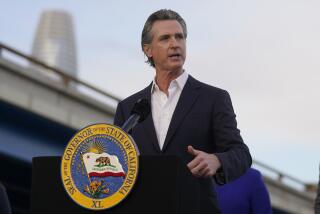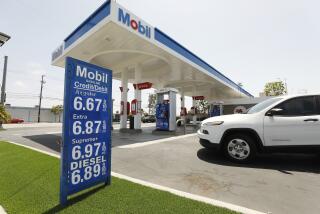Third Shock Due
- Share via
WASHINGTON — Just as Americans are gearing up their SUVs for summer vacations, oil prices that Energy Secretary Bill Richardson promised would go down are starting to creep up again and may hit $40 or more a barrel by winter, if not sooner. Similar looming shortages of natural gas and home heating oil may even lead some to cry “crisis” this winter. Yet, with the Clinton administration spinning it as a problem solved, few have noticed that the world has entered an oil-supply situation more precarious than at any time since the 1973 oil shock.
Should Saddam Hussein decide to yank his 2.7 million barrels of daily oil off the world market to protest sanctions against his regime, the ensuing scramble may wreak more economic havoc than the Gulf crisis. There is far less spare oil in the world today than in 1990, either in commercial inventory or that the Organization of Petroleum Exporting Countries can readily extract from the ground. Furthermore, it may be more difficult for policymakers to respond to an “emergency” that involves no act of war.
True, oil prices came off their $34 highs after OPEC recently raised its output, but, as oil economist Philip K. Verleger Jr. suggests, “The world may soon be confronted with its third oil shock.” In an election year, the risk of politicians spouting foolish energy policy should not be underestimated.
The details of how the world suddenly became short of oil are complicated and political. But there hasn’t been any decline in the amount of total oil reserves--more than 2.3 trillion barrels, 6 trillion if unconventional reserves are added. The problem is that no one is extracting the oil fast enough. One reason is that oil companies cut exploration and drilling budgets when prices were low, and even as prices recovered, they were distracted by such concerns as digesting mega-mergers. More recently, companies have started investing again, but it will be 18 to 24 months before this spending translates into increased output.
Another reason is that OPEC stopped investing in its oil fields, in some cases because U.S. sanctions policy blocked it, in others because internal political pressures forced governments in Saudi Arabia and Venezuela to siphon revenues from the state oil industry to spend on social programs. Domestic politics inside OPEC also favored seeking higher prices and less investment, hence, the group’s unusually robust production-restraining agreement. When the continuing dynamism of the U.S.-led global economy and an unexpectedly swift Asian recovery boosted oil demand, consumers were forced to tap into inventories, draining them to historic lows. According to the U.S. Department of Energy, global oil use will average 1.2 million barrels more a day in the last quarter of this year than for the same period in 1999. With no oil stocks building this summer, it’s not clear where all this oil will come from next winter.
OPEC is producing about 27.5 million barrels of oil a day. Along with Mexico and Norway, the cartel has kept more than 1 billion barrels off the market since its March 1999 agreement to lift oil prices. That is more than double the 420 million barrels lost during the entire Gulf crisis.
OPEC is supposed to boost production if prices stray beyond a target range of $22-28 a barrel. Oil producers are talking about hiking output by about 500,000 barrels in an attempt to bring prices back into line. But larger volumes are required to replenish inventories and thereby keep markets from overheating this winter. OPEC can supply some 2 million barrels a day in additional oil.
In such a tight market, lesser producers like Iraq enjoy increased leverage. The only producer capable of countering efforts to undermine price stability is Saudi Arabia. Currently producing about 8 million barrels of oil a day, the Saudis hold the majority share of the world’s spare production capacity. Riyadh says it’s able and willing to raise production to 10 million barrels a day if need be, but it has been many years since it achieved those levels. A lack of sustained investment in Saudi oil fields since 1990 limits Riyadh’s capacity to increase its output beyond 2 million to 3 million barrels a day for more than a short period of time. Ironically, Riyadh has begun investment talks with foreign oil companies in virtually every aspect of the oil business other than upgrading its oil fields.
There are a number of possible U.S. policy responses that would ameliorate the situation regardless of whether OPEC increases production. The most obvious is to tap the Strategic Petroleum Reserve to inject more oil into the market and stabilize prices. The U.S. government owns 568 million barrels of oil; together, consuming countries control 1.2 billion barrels of crude and oil products.
The strategic reserve has attained a status not unlike that of Social Security: Nobody wants to touch it. But there has been a radical shift in the nature of the oil market since the 1970s. What was once a rigid, long-term contract market is now a free-wheeling, global spot-oil arena. As a result, rising prices affect all buyers, and available supplies go to the highest bidder. Furthermore, no canceled fixed-price contracts will signal when a crisis has begun. It will be a question of political judgment.
One idea is to allow companies to borrow oil from the reserve to stabilize the market and replenish it at a profit when prices adjust downward. But who needs a middle man? Why not let the U.S. government tap the strategic reserve if necessary and let the public profit from its replenishing? If the government can turn a profit by selling oil when it’s needed, and buying it back in 2001 when oil-exploration investment translates into rising output, why not use the money to invest in alternative-energy technologies? The key requirement is to replenish the stockpile within a certain time frame. The longer-term outlook is for prices in the $15-$20 range.
Analysis shows that despite structural shifts in the U.S. economy, oil-price spikes can dampen its dynamism. Declaring what price levels would open the strategic reserve could prevent economic damage: It would give Riyadh an incentive to raise production and also check oil speculators.
The Senate will soon begin hearings on a new National Energy Security Act. The goal of this legislation is to reduce oil imports from 55% to 50%. This is an arbitrary goal. Given how oil markets work, a price spike anywhere is a price spike everywhere. Thus, how much a country imports is not vitally important. If the U.S. is concerned about oil dependency and prices, there are a number of ideas the proposed legislation raises that point in the right direction: tax breaks for natural-gas production and alternative-energy resources, and measures to stimulate domestic production. Oil producers should also be encouraged to alter their tax regimes to attract foreign investment, and the U.S. should offer loans to poorer oil producers such as Mexico, Indonesia and Russia directly earmarked for their oil and gas sectors. In addition, tax credits for the purchase of hybrid or fuel-cell cars and fuel-cell-powered residences and office buildings would also have a major long-term impact on both prices and foreign-oil dependency.
Markets and technology have solved many of the problems of the 1970s. Today’s short-term oil problem is an anomaly. Longer term, increased investment and advanced oil-production technology will augment supply and reduce prices. Thus, the issue is how to get through a long, hot summer and a cold winter. Quietly ensuring that Saudi Arabia can boost production and planning ahead when and how to use the Strategic Petroleum Reserve are two good steps. But, above all, remember the first rule of public policy: Do no harm. *
More to Read
Sign up for Essential California
The most important California stories and recommendations in your inbox every morning.
You may occasionally receive promotional content from the Los Angeles Times.












